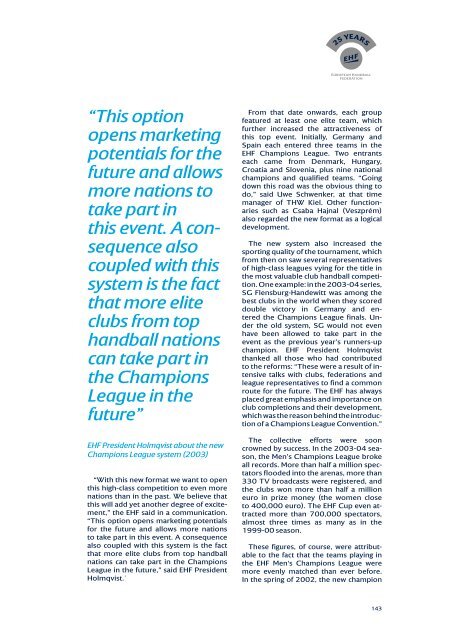ehf_25yers_book_webversion
You also want an ePaper? Increase the reach of your titles
YUMPU automatically turns print PDFs into web optimized ePapers that Google loves.
“This option<br />
opens marketing<br />
potentials for the<br />
future and allows<br />
more nations to<br />
take part in<br />
this event. A consequence<br />
also<br />
coupled with this<br />
system is the fact<br />
that more elite<br />
clubs from top<br />
handball nations<br />
can take part in<br />
the Champions<br />
League in the<br />
future”<br />
EHF President Holmqvist about the new<br />
Champions League system (2003)<br />
“With this new format we want to open<br />
this high-class competition to even more<br />
nations than in the past. We believe that<br />
this will add yet another degree of excitement,”<br />
the EHF said in a communication.<br />
“This option opens marketing potentials<br />
for the future and allows more nations<br />
to take part in this event. A consequence<br />
also coupled with this system is the fact<br />
that more elite clubs from top handball<br />
nations can take part in the Champions<br />
League in the future,” said EHF President<br />
Holmqvist.´<br />
From that date onwards, each group<br />
featured at least one elite team, which<br />
further increased the attractiveness of<br />
this top event. Initially, Germany and<br />
Spain each entered three teams in the<br />
EHF Champions League. Two entrants<br />
each came from Denmark, Hungary,<br />
Croatia and Slovenia, plus nine national<br />
champions and qualified teams. “Going<br />
down this road was the obvious thing to<br />
do,” said Uwe Schwenker, at that time<br />
manager of THW Kiel. Other functionaries<br />
such as Csaba Hajnal (Veszprém)<br />
also regarded the new format as a logical<br />
development.<br />
The new system also increased the<br />
sporting quality of the tournament, which<br />
from then on saw several representatives<br />
of high-class leagues vying for the title in<br />
the most valuable club handball competition.<br />
One example: in the 2003-04 series,<br />
SG Flensburg-Handewitt was among the<br />
best clubs in the world when they scored<br />
double victory in Germany and entered<br />
the Champions League finals. Under<br />
the old system, SG would not even<br />
have been allowed to take part in the<br />
event as the previous year’s runners-up<br />
champion. EHF President Holmqvist<br />
thanked all those who had contributed<br />
to the reforms: “These were a result of intensive<br />
talks with clubs, federations and<br />
league representatives to find a common<br />
route for the future. The EHF has always<br />
placed great emphasis and importance on<br />
club completions and their development,<br />
which was the reason behind the introduction<br />
of a Champions League Convention.”<br />
The collective efforts were soon<br />
crowned by success. In the 2003-04 season,<br />
the Men’s Champions League broke<br />
all records. More than half a million spectators<br />
flooded into the arenas, more than<br />
330 TV broadcasts were registered, and<br />
the clubs won more than half a million<br />
euro in prize money (the women close<br />
to 400,000 euro). The EHF Cup even attracted<br />
more than 700,000 spectators,<br />
almost three times as many as in the<br />
1999-00 season.<br />
These figures, of course, were attributable<br />
to the fact that the teams playing in<br />
the EHF Men‘s Champions League were<br />
more evenly matched than ever before.<br />
In the spring of 2002, the new champion<br />
143














